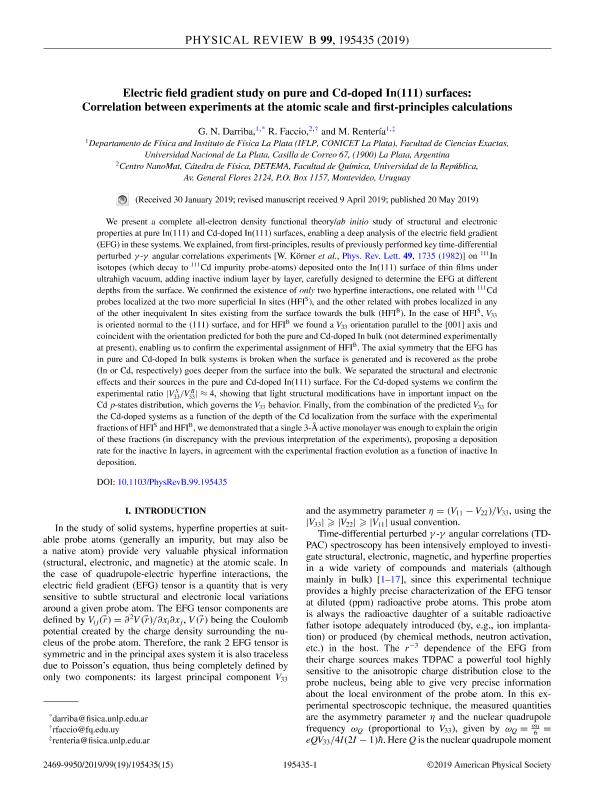Artículo
Electric field gradient study on pure and Cd-doped In(111) surfaces: Correlation between experiments at the atomic scale and first-principles calculations
Fecha de publicación:
20/05/2019
Editorial:
American Physical Society
Revista:
Physical Review B
ISSN:
2469-9950
Idioma:
Inglés
Tipo de recurso:
Artículo publicado
Clasificación temática:
Resumen
We present a complete all-electron density functional theory/ab initio study of structural and electronic properties at pure In(111) and Cd-doped In(111) surfaces, enabling a deep analysis of the electric field gradient (EFG) in these systems. We explained, from first-principles, results of previously performed key time-differential perturbed γ-γangular correlations experiments [W. Körner et al., Phys. Rev. Lett. 49, 1735 (1982)10.1103/PhysRevLett.49.1735] on In111 isotopes (which decay to Cd111 impurity probe-atoms) deposited onto the In(111) surface of thin films under ultrahigh vacuum, adding inactive indium layer by layer, carefully designed to determine the EFG at different depths from the surface. We confirmed the existence of only two hyperfine interactions, one related with Cd111 probes localized at the two more superficial In sites (HFIS), and the other related with probes localized in any of the other inequivalent In sites existing from the surface towards the bulk (HFIB). In the case of HFIS, V33 is oriented normal to the (111) surface, and for HFIB we found a V33 orientation parallel to the [001] axis and coincident with the orientation predicted for both the pure and Cd-doped In bulk (not determined experimentally at present), enabling us to confirm the experimental assignment of HFIB. The axial symmetry that the EFG has in pure and Cd-doped In bulk systems is broken when the surface is generated and is recovered as the probe (In or Cd, respectively) goes deeper from the surface into the bulk. We separated the structural and electronic effects and their sources in the pure and Cd-doped In(111) surface. For the Cd-doped systems we confirm the experimental ratio |V33S/V33B|≈4, showing that light structural modifications have in important impact on the Cd p-states distribution, which governs the V33 behavior. Finally, from the combination of the predicted V33 for the Cd-doped systems as a function of the depth of the Cd localization from the surface with the experimental fractions of HFIS and HFIB, we demonstrated that a single 3-Å active monolayer was enough to explain the origin of these fractions (in discrepancy with the previous interpretation of the experiments), proposing a deposition rate for the inactive In layers, in agreement with the experimental fraction evolution as a function of inactive In deposition.
Archivos asociados
Licencia
Identificadores
Colecciones
Articulos(IFLP)
Articulos de INST.DE FISICA LA PLATA
Articulos de INST.DE FISICA LA PLATA
Citación
Darriba, German Nicolas; Faccio, Roberto Jose; Rentería, Mario; Electric field gradient study on pure and Cd-doped In(111) surfaces: Correlation between experiments at the atomic scale and first-principles calculations; American Physical Society; Physical Review B; 99; 195435; 20-5-2019; 1-15
Compartir
Altmétricas




